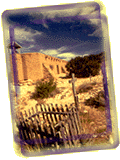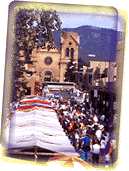 |
 |
 |
|
|||
|
Exotic Treasure in Santa Fe Once a year, near the end of July, I compromise with the sleep god Morpheus and set my alarm for 7:30 a.m. I want to be there for the 8 o'clock opening of what I consider to be the best-kept secret in the Southwest: Santa Fe's exotic, delicious, melodious Spanish Market. The downtown Plaza is crowded with white billowy vendors' tents. Inside them, more than 300 northern New Mexican artists display their creations. They've been working toward this event all year because it's their prime opportunity to exhibit and sell their work.They're anxious to give visitors a crash course in traditional Hispanic art and culture.
Artist: "These are religious carvings and paintings called bultos and retablos. A bulto is a statue of a saint carved in the round. Some of the pigments are made from roots and different minerals. A retablo is a piece of board used as a canvas to make a painting of a saint. When the settlers first came here, there was no such thing as canvas, so wood was used. My prices range from $100 to three or four thousand dollars"
Artist: "This is all New Mexican tin work which goes back for many generations. It's all hand-cut and hand-stamped. I carry everything from large mirrors to pictures frames. The mirrors go from $l0 to $600."
Second Artist: "Micacious clay pottery, pottery you cook in. You collect the clay in the forest. It's mud. You pick it up and clean it up."
Third Artist: "I'm selling Spanish traditional textiles based on natural vegetable dyes." As the world becomes increasingly homogenized, it's exciting to see that unique Hispanic traditions are being preserved and passed down. It is not unusual to have several generations selling at Spanish Market. Eleven-year-old Mario is a veteran who's been displaying his weavings for many summers.
In the middle of the plaza, people in the know gather to observe and purchase the work of l00 other very busy kids. When you buy art from a five or 15- year-old, you may be discovering a future artist whose works will sell for thousands. Brianna Montoya seems to be well on her way.
Throughout the entire weekend, the plaza comes alive with singing and dancing. Once again, the kids steal the show. Even the littlest ones, who are about 3 years old, execute intricate turns and twirls as they pay homage to their culture. When they grow up, their dancing becomes more sophisticated and electric: Of course, tourists can't feed on art alone. An entire street is dedicated to native cuisine. Roque is a chef who performs culinary miracles on the grill of his pushcart.
Roque: "I'm famous all over the world for my carnitas. I've been in Gourmet Magazine twice. I do mine with beef. The top round. I cut it very thin and marinate it for at least 24 hours. I put 'em in the flames with chili and onion and I put the salsa on top of the meat. That's why we have so many people. They come not only to shop around but to eat our food. Spanish Market -- they pick the best of the arts and crafts and the best of the food here in Santa Fe. " If you can't make it here in the summer, every winter there's the smaller Spanish Market. Even though it's indoors, you can still experience the art, the entertainment, the food and the magic of northern New Mexico. From the Santa Fe Plaza, this is Judie Fein for The Savvy Traveler.
|
 | American Public Media Home | Search | How to Listen ©2004 American Public Media | Terms of Use | Privacy Policy |

 I'm a big fan of retablos. I buy new ones every year to watch over me. But
there's a great range of other artwork to choose from also.
I'm a big fan of retablos. I buy new ones every year to watch over me. But
there's a great range of other artwork to choose from also.
 The guidelines for entry into the traditional Spanish market are very strictly
defined, but for those with more modern taste, there is a special section
reserved for contemporary Hispanic artists. Samuel Quintana creates what he
calls "spiritual surrealism," miniature sculptures carved from the South
American tagua nut, which is about the size of a walnut. He also displays
his gorgeous hand-made guitars which he plays for the visitors.
The guidelines for entry into the traditional Spanish market are very strictly
defined, but for those with more modern taste, there is a special section
reserved for contemporary Hispanic artists. Samuel Quintana creates what he
calls "spiritual surrealism," miniature sculptures carved from the South
American tagua nut, which is about the size of a walnut. He also displays
his gorgeous hand-made guitars which he plays for the visitors.